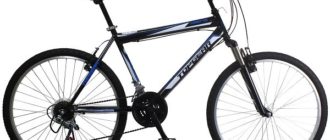The bicycle was invented in the middle of the 19th century. It began to be actively used somewhere in the mid-60s, when people needed to travel long distances. At about the same time, domestic designers introduced the bicycle with a gasoline engine to a wide audience. Soviet development was to simplify the use of two-wheeled transport as much as possible.
In the Soviet Union, such bicycles were called “holes”, so residents of the former Soviet Union should be familiar with them. The era of the Soviet Union is gone, and with it the production of gasoline engines for bicycles ceased. The market was flooded with cheap imported two-stroke motors from China, which even today occupy the leading positions on the market.
History of origin
For the first time a gasoline motor for a bicycle was produced at the Red October plant. There was also a large-scale production for mass consumers. The factory produced tens of millions of gasoline engines of category “D”, which allowed them to reach a record speed of 80 km/h for that time and for the corresponding transport. Moreover, the DOSAAF regularly organized competitions on gasoline-powered bicycles. Of course, this bike opened up great opportunities for its owner: where conventional bikes would not pass – easily pass a bike with a gasoline engine.
The innovation appealed to cyclists, and very soon the so-called velomopeds became a common phenomenon. They were convenient to go fishing, to the cottage, to mushrooms – excellent Cross-country—what-it-is–nuances ability, which was in the hands of Soviet citizens. Over time, the French joined the Soviet production of bicycle engines – so the production of engines under the MotoBekan brand was established.
Today, the most famous and sought-after manufacturer of bicycles with a gasoline engine is the Chinese factory Forester. The company is engaged in the production of bicycles with engines up to 4.5 horsepower. It should be said that the products of Chinese craftsmen are in a quite affordable price segment – a new bike can be bought for 30-35 thousand rubles.
Features of bicycles with a gasoline engine
In fact, this is a kind of alternative to a scooter and an ordinary bicycle. An engine is attached to the frame of the vehicle – most often it is a two-stroke motor with a capacity of 1 horsepower. Power can be more, but not more than 4.5 hp The volume of internal combustion chamber is 45-50 cm cubic, which does not allow to refer motopeds to the category of motorcycles.
It is clear that the case is not limited to the installation of the motor alone on the frame of the bicycle. The design involves the presence of a muffler, gas tank, gearbox, clutch lever and throttle lever. The fuel tank of the bike holds about 1.5 liters of gasoline. “Eats” a little of this transport – about 2 liters per 100 kilometers. Fuel before use diluted with engine oil, the amount which depends directly on the “seniority” of the engine.
The motor on the bicycle frame can be located in different ways. For example, on older models, a tube was drilled, as a result of which the location of the motor was inconvenient. Today, modern models are equipped with special fasteners that allow you to install the motor without violating the integrity of the design. In this case, the installation of the power unit absolutely does not interfere with the cyclist and does not have to change the design of the bike. On some motorcycles, the engine can be found on one of the wheels.
By the way, some cyclists easily improve their iron horses, installing their own motors. In particular, such powerful engines such as “Spring-20” or “Friction” is easy to install even on three-wheeled bikes, designed for the elderly.
An important feature of such bikes is that you can continue to move even without running the engine – just turning the pedals as usual. But sometimes there are situations when it is impossible to do without help. For example, climbing Uphill—how-to-learn–tips – it is very useful help of some “horses”.
Types .
The presented classification of motorcycles is made taking into account the type of engine and clutch, which the vehicle is equipped with. Here, two parameters should be taken into account:
- On modern models put two- or four-stroke engines. The first are characterized by economy, low power and acceptable cost – suitable for leisurely riding on a relatively flat surface. Four-stroke engines are more powerful, allow you to reach higher speeds and at the same time consume relatively little fuel.
- The way torque is transmitted to the wheel and the layout of the motor is the second criterion.
According to the way torque is transmitted to the wheel, motorcycles come in two types:
- Models equipped with a disc clutch motor. The motor is located above the pedal carriage in a frame fork, connected to the rear sprocket by a chain. The clutch handle is located on the handlebar on the left side. Such models can be started with a tow, but at the same time they require additional equipment (fuel tank, clutch handle and shield).
- Models with centrifugal clutch. Motors of this type are designed according to the monoblock type, which includes a fuel tank, muffler, clutch and ratchet starting mechanism. Despite the large number of complex assemblies, this design proves to be quite compact and lightweight. The centrifugal clutch allows you to start the engine with just a push of the throttle grip. The engine kill switch allows you to stop the bike. There is no clutch handle in these models. One of the main advantages of these models is ease of operation. As for the disadvantages – high noise level.
The last points are worth talking about separately. Someone does not see the significant advantages of a bicycle with a gasoline motor. And someone has long appreciated their qualities and rides with pleasure.
Advantages and disadvantages
Disputes about the advisability of installing a gasoline engine on a bicycle have not subsided to this day. Someone appreciates such a technique for the fact that for the movement it is necessary to apply a minimum of effort, and rises in the mountain are now much easier and faster. Consider other advantages:
- There is no need to constantly turn the pedals. The engine provides good traction on virtually any surface.
- If you follow the manufacturer’s recommendations and properly care for the vehicle, you can end up with a very long service life. The service life of the gasoline motor is at least 10 years.
- Simple device of the mechanism. The engine is two-stroke, which means that it is easy to rebuild, clean and replace, if necessary, any elements. Even an inexperienced person who has never dealt with power units before will be able to fix the problem.
- Low Consumption. Since most engines are low-power, they consume only 2000 ml of fuel per 100 km.
- Some models are equipped with a shift transmission. This quality allows you to get even more speed on the output, without resorting to any structural metamorphosis.
- The movement can continue, even if you run out of gas or have any problems with the engine on the road – no one forbids to spin the pedals and move, as on a normal bicycle.
- There is additional functionality. As a rule, modern bicycles with a gasoline engine are equipped with a generator, from which the rear and front lights work. They are also equipped with a speedometer, a set of wings and other accessories.
- Low weight. On average, the dry weight of a bicycle with a gasoline engine is about 30 kg.
It would seem that better technology can not find, but it was not there. There are such bikes have significant disadvantages. They are few, but their presence is impossible not to notice:
- The absence of a normal transmission. This is especially felt when you have to turn off the engine and turn the pedals in the traditional way.
- Noise. If you like to ride quietly on rolling forest roads, enjoy the sounds of the forest and birdsong, then with a gasoline engine you will no longer have this opportunity.
- Lack of physical exertion. The opportunity to twist the gas handle and rush forward – very tempting. There is no need to strain, to twist pedals, to control your breath and to feel pleasant fatigue in legs. Here already much depends on the consciousness of the driver: from time to time on a flat area it is possible to switch off the motor and provide physical strain to maintain a tone.
And perhaps the most important and significant disadvantage that can not be left without attention – the formerly environmentally friendly transport becomes the same source of harmful emissions and toxic gases.
Recommendations on a choice
So, if you do decide to buy a bicycle, you should pay attention to a number of important points:
- Transmission. Most motorcycles have the usual constant transmission, which means that it is impossible to change the speed of movement with the same motor power. Therefore, if you plan to travel long distances, it makes sense to look for a model with a transmission.
- Diameter of wheels. The optimal size is 26 inches. These wheels provide a good Cross-country—what-it-is–nuances ability. In addition, to find them spare parts will not be difficult.
- Gearbox. The most preferred is the model with a reduction gear, which has a sufficient transmission ratio of 5:1. These are the most reliable and convenient mechanisms.
- Motor. When choosing, you should focus on the products of well-known brands that have managed to earn a good reputation. If you choose the budget Chinese model, make a trial run of the motor, allowing him to work idle. If it does not show stains and leaks of fuel – then the engine is assembled well enough.
The cost of bicycles with a gasoline engine ranges from 15 to 40 thousand rubles. For example, a bicycle Forester GMG (available with a single-cylinder motor modifications F50 and F80), complete with a dry friction clutch, protective guards and a fuel tank with a capacity of 4 liters, will cost about 32 thousand. But the exact same model will cost much cheaper.
Conclusion
The gasoline engine requires regular attention and proper care. However, like any other complex mechanism. It is worth noting that there are other types of power units that can be installed on a bicycle – these are electric motors and motors running on gas.
Motorized bicycles are a comfortable means of transportation, allowing you to travel long distances with minimal physical exertion. Keep in mind that such a unit requires registration with the relevant authorities and a driver’s license.











This is a great article! I love the idea of having a bicycle with a gasoline engine to make my commutes more efficient and eco-friendly. Can’t wait to learn more about its features and tips on how to get the most out of it!
This is an interesting topic! I’m interested to learn more about these bicycles with a gasoline engine. What are the main features of them and what tips would you suggest for those looking to purchase one?